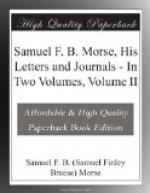“In the earlier period of the invention it was a matter which experience alone could determine whether the numerical system, by means of a numbered dictionary, or the alphabetic mode, by spelling of the words, was the better. While I perceived some advantages in the alphabetic system, especially in the writing of proper names, I at that time leaned rather towards the numerical mode under the impression that it would, on the whole, be the more rapid. A very short experience, however, showed the superiority of the alphabetic mode, and the big leaves of the numbered dictionary, which cost me a world of labor, and which you, perhaps, remember, were discarded and the alphabetic installed in its stead.” Perhaps the most conclusive evidence that Vail did not invent this alphabet is contained in his own book on the “American Electro-Magnetic Telegraph,” published in 1845, in which he lays claim to certain improvements. After describing the dot-and-dash alphabet, he says:—
“This conventional alphabet was originated on board the packet Sully by Professor Morse, the very first elements of the invention, and arose from the necessity of the case; the motion produced by the magnet being limited to a single action. During the period of the thirteen years many plans have been devised by the inventor to bring the telegraphic alphabet to its simplest form.”
The italics are mine, for the advocates of Vail have always quoted the first sentence only, and have said that the word “originated” implies that, while Vail admitted that the embryo of the alphabet—the dots and dashes to represent numbers only—was conceived on the Sully, he did not admit that the alphabetical code was Morse’s. But when we read the second sentence with the words “devised by the inventor,” the meaning is so plain that it is astonishing that any one at all familiar with the facts could have been misled.
The first form of the alphabet which was attached to Morse’s caveat of October 3, 1837, is shown in the drawing of the type in the accompanying figure.
[Illustration: ROUGH DRAWING OF ALPHABET BY MORSE Showing the first form of the alphabet and the changes to the present form]
It has been stated by some historians that the system of signs for letters was not attached to the caveat, but a careful reading of the text, in which reference is made to the drawing, will prove conclusively that it was. Moreover, in this caveat under section 5, “The Dictionary or Vocabulary,” the very first sentence reads: “The dictionary is a complete vocabulary of words alphabetically arranged and regularly numbered, beginning with the letters of the alphabet.” The italics are mine. The mistake arose because the drawing was detached from the caveat and affixed to the various patents which were issued, even after the first form of the alphabet had been superseded by a better one, the principle, however, remaining the same, so that it was not necessary to patent the new form.




